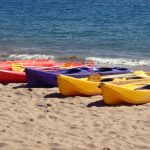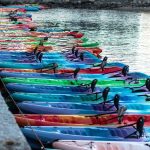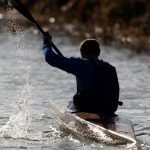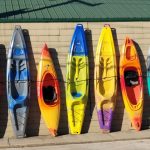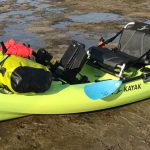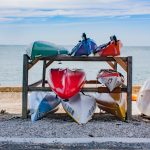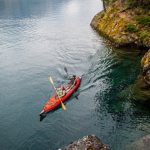Buying your first kayak can be quite an experience, there are so many models! This article will help you choose between a sit-in and a sit-on-top kayak.

One of the main reasons people take up kayaking is the ability to explore new areas. Whether it’s laying under a tarp listening to the waves washing up the beaches of a Norwegian fjord, or watching fireflies dance overhead as I fall asleep under the stars next to a river in Nepal, many of my favorite kayaking memories involve overnight adventures. Kayaks have taken people all around the world into the most remote regions but have also given many budding explorers their first taste of true adventure.
Whether you’re looking to go on a short overnight trip on your lake, head out fishing with your buddies, and want to have a few drinks and a camp, or you’re a keen sea kayaker on a mission to cover huge distances, you need the right camping kayak. The kayaks on our list are designed to carry the gear you need on a camping trip, as well as keep you comfortable on the water.
At a glance: The Best Kayaks for Camping
Best Sit-in Camping Kayak: Wilderness Systems Pungo 125
Best Sit-on-top Camping Kayak: Crescent CK1 Venture
Best for Kayak Fishing Camping: Ascend H12
Best Inflatable: Sea Eagle 385 FT
For River Camping: Dagger Katana
For Sea Kayak Camping: Wilderness Systems Tempest 170
For Tandem Kayak Camping: Ocean Kayaks Zest Two EXP
Comparison Table: Best Kayaks for Camping
| Model | Specs | Where To Buy |
Wilderness Systems Pungo 125 | Size: 12 ft. 6 in. x 29 in. Weight: 53 lbs. Capacity: 375 lbs. | Amazon |
Crescent CK1 Venture | Size: 11 ft. x 34 in. Weight: 60 lbs. Capacity: 400 lbs. | Crescent Kayaks |
Ascend H12 | Size: 12 ft. x 32 in. Weight: 76 lbs. Capacity: 450 lbs. | Bass Pro Shops |
Sea Eagle 385ft | Size: 12 ft. 5 in. x 36 in. Weight: 35 lbs. Capacity: 635 lbs. | Amazon |
Dagger Katana | Size: 10 ft. 4 in. x 27.25 in. Weight: 56 lbs. Capacity: Not stated | Amazon |
Wilderness Systems Tempest 170 | Size: 17 ft. x 22 in. Weight: 57 lbs. Capacity: 325 lbs. | Amazon |
Ocean Kayaks Zest Two EXP | Size: 16 ft. 4.5 in. x 30.5 in Weight: 95 lbs. Capacity: 600 lbs. | Amazon |
The Best Kayaks for Camping
Best Sit-in Camping Kayak: Wilderness Systems Pungo 125

Length: 12 ft. 6 in. (3.81 m)
Width: 29 in. (75 cm)
Weight: 53 lbs. (24 kg)
Capacity: 375 lbs. (170 kg)
Material: Romotmolded plastic
The Wilderness Systems Pungo 125 is perhaps the ultimate sit-in recreational touring kayak and this extends into camping territory too. Perhaps the most notable feature of the Pungo is the extra large cockpit area. One of the most daunting aspects of a sit-in kayak for many paddlers is the feeling of restriction, but the extra large cockpit gives you space and freedom without feeling constrained.
When you’re out on a camping trip you usually have things that you want close to hand – camera, phone, snacks, a morning coffee – and the kayak dashboard at the front of the cockpit gives you a great place to stow these on the go. This features two cup holders, a DryTec box for your valuables, as well as a recess to fit a lithium battery to keep you topped up on the go. Other items can be stowed under the deck bungee, and there is plenty of storage in the watertight hatch for overnight equipment.
The hull shape of the Pungo 125 is designed to balance speed and stability. Although it’s not the widest kayak on the market, for a sit-in it does have a high level of primary stability. The waterline is extended out past the stern, giving you a higher top speed and better tracking, though this will impact your turning in tight spaces a little.
Pros:
- Extra large cockpit for access
- Kayak dashboard
- High capacity
- Longer waterline for better speed and tracking
- Plenty of onboard storage options
Cons:
- Storage for camping equipment is limited to a single hatch
- The larger cockpit can make this kayak uncomfortable for smaller framed kayakers
Best Sit-on-top Camping Kayak: Crescent CK1 Venture

Length: 11 ft. (3.35 m)
Width: 34 in. (86 cm)
Weight: 60 lbs. (27.2 kg)
Capacity: 400 lbs. (181 kg)
Material: Aqua Tuff Resin
The Crescent CK1 Venture is unusual among sit-on-top kayaks, in that it focuses more on secondary stability than it does on the primary. Because of this, the CK1 Venture may take a little getting used to when you first hit the water, but once you do you’ll realize there’s a whole world of kayaking that a lot of sit-on-tops are missing out on. The hull design gives this kayak a much more playful and maneuverable feel than you would expect, losing that heavy and sluggish feeling that a lot of sit-on-tops come with.
Perhaps the most appealing features of the CK1 Venture are the open deck design and load haulage capacity. The water-resistant cover at the bow stows your gear securely but can also expand to allow for more equipment as you load up. At the stern, the shock cord that secures your equipment is on fully adjustable gear tracks, so you can move it around or even remove it completely for easier access.
Once you’ve loaded all of that gear onboard, you still want your kayak to ride high and dry where possible. The CK1 Venture is designed for folks that like a bit of rough water, and nowhere is that more apparent than at the bow. The rocker profile combines with a bulbous nose section that adds buoyancy and keeps the nose riding high, even when you’re fully packed out for an overnight trip. This stops you from diving deep into waves and reduces the chances that your sleeping bag is going to end up soaked through.
Pros:
- Playful and versatile kayak
- Storage options that can be changed up
- Nose keeps you riding high over waves
Cons:
- Can take some getting used to at first
Best for Kayak Fishing Camping: Ascend H12

Length: 12 ft. (3.65 m)
Width: 32 in. (81 cm)
Weight: 76 lbs. (34 kg)
Capacity: 450 lbs. (204 kg)
Material: Rotomolded plastic
The Ascend H12 is a gear hauler’s dream kayak. This thing has some serious capacity and what’s more, Ascend has thought about how it can be distributed evenly throughout the kayak. The bow storage is secured with a splashproof plastic casing and bungee cord, but can also be accessed from the hull itself. The stern storage is secured using an elasticated water-resistant cover, held on with six small hooks.
When you’re on the move, you don’t want to be getting up to access your overnight pack. There are three storage saddle bags, one on either side under the gunwales and the other behind the seat. These give you a combination of mesh and waterproof storage, so you can stow snacks, cameras, cell phones, and anything else securely.
The H12 is a combination of canoe and kayak. The deep-seated position and high sides give you a reasonable level of protection from waves and wind while retaining that lower profile of a kayak. The recessed keel line turns this kayak into a pontoon-type setup, giving you enormous primary stability for standing and moving about, however, the step system does mean that rocks and logs are channeled to the center of the kayak and impact hard on the stern.
Pros:
- Fully fishing-ready kayak
- Loads of storage
- Saddle bags
- Supportive seating
- Stable pontoon design
Cons:
- Hard impacts on the keel
- High-sided design can make paddling hard for smaller paddlers
- Heavy
Best Inflatable: Sea Eagle 385ft
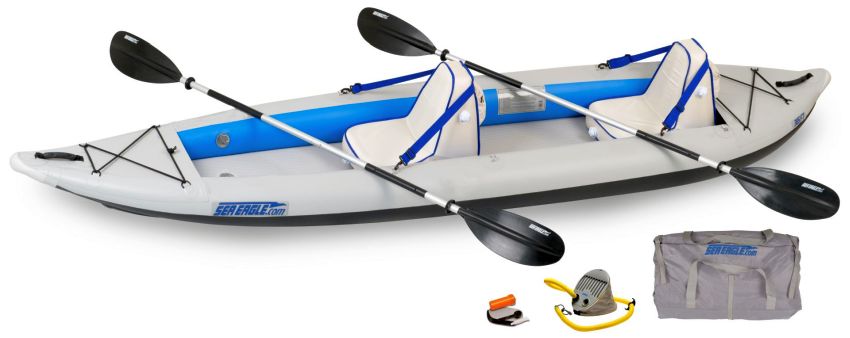
Length: 12 ft. 5 in. (3.81 m)
Width: 36 in. (91 cm)
Weight: 35 lbs. (16 kg)
Capacity: 635 lbs. (288 kg)
Material: 1100 Decitex Reinforced
Inflatable kayaks are on the rise and among the companies making them, Sea Eagle is one at the forefront of the industry. The 385ft is billed as a three-person kayak, but in reality, it’s better suited to being a two-person touring and overnight option. The space and capacity fit two adults comfortably, along with overnight camping equipment.
The 385ft is built to tour. This lightweight kayak is shaped to cut through the wind and ride high over the top of waves. At the bow, Sea Eagle has fitted its NeedleKnife keel line. This extra inflatable chamber sits deeper into the water than the hull, gripping against wind and waves for better tracking capabilities. A removable skeg at the stern enhances this further, leaving the mid-section of the kayak flatter for stability.
The 385ft is low profile, in terms of inflatable kayaks. The chambers sit low enough that even smaller paddlers have no problem reaching over the sides, but this does mean that waves are more likely to crash into the kayak. Splash decks at the front and stern of the kayak are fitted for you to stow your equipment, but in reality, most of your gear will be in a dry bag stowed behind the bow paddler. Fortunately, there are plenty of D-ring attachment points to keep your gear secure.
Pros:
- Lightweight inflatable kayak
- NeedleKnife bow for better tracking capabilities
- Stable and easy to paddle
- Moveable seats
Cons:
- Fairly cramped for two large adults and gear
- Inflatable kayaks are more heavily affected by wind
For River Camping: Dagger Katana

Length: 10 ft. 4 in. (315 cm)
Width: 27.25 in. (69 cm)
Weight: 56 lbs. (25 kg)
Capacity: Not stated, but optimal paddler weight 155 – 285 lbs. (70 – 129 kg)
Material: Rotomolded Plastic
Sure, there are other kayaks on this list that can be used on rivers, but if you want a kayak suited to white water, cruising rapids, and finding the idyllic spot at the end of the day, you need a closed cockpit, fully controllable kayak. But the Dagger Katana is much more than that. The versatile, rounded hull design makes this kayak suitable for all styles of kayak camping, though you won’t want to be kayaking long stretches of open water in it.
The Katana takes a lot of its hull design from the Dagger Mamba, perhaps the most popular creek kayak in the US in the past two decades. This high caliber of design gives you high stability, softer edges, and a top deck that sheds water to carry speed. Inside, the Katana features the same Contour Ergo outfitting that Dagger uses in all of their white water spec kayaks. This outfitting is fully customizable to give you optimal control when it counts.
Of the kayaks on this list, the Katana has the least internal storage space. There is a large storage hatch at the rear of the kayak as well as top deck bungee, though, so there is plenty of space to stow your camping kit. When you’re negotiating the twists and turns of the river, you need your kayak to remain responsive. For river camping, you’re not likely to carry as much camping gear as you would usually, so this reduced storage space is still more than adequate for everything you’ll need.
Pros:
- Inspired by Dagger’s top-end creek kayak
- Adjustable and connective outfitting
- Large storage hatch
- Capable on up to class III/IV white water
- Drop down skeg for open water sections
Cons:
- Limited storage compared to other kayaks on the list
- No outright capacity stated
For Sea Kayak Camping: Wilderness Systems Tempest 170

Length: 17 ft. (5.18 m)
Width: 22 in. (56 cm)
Weight: 57 lbs. (26 kg)
Capacity: 325 lbs. (147 kg)
Material: Rotomolded Plastic
The Wilderness Systems Tempest 170 is the largest in the Tempest range, a series of kayaks designed to give paddlers of every size the opportunity to enhance their sea kayaking skills. The Tempest 170 is a kayak camping boat for those who want to do more than head out overnight. This is a kayak for long trips, covering great distances on open water and in sea swell or breaking waves.
The Tempest 170 balances a long waterline with a mid-range rocker profile at the bow. This helps you to maintain a high speed across the water and negates some of the impacts of wind but also lets you ride drier over big swells and breaking waves, reducing fatigue on long journeys. The drop-down skeg at the stern will help you track against the wind and keep a truer course, so you don’t spend your days readjusting and fighting against the elements.
There is almost no end to the storage options on the Tempest 170. The large bow and stern storage hatches provide plenty of space for your camping equipment, while the midship hatch can be used as a day hatch, separating out snacks and essentials that you’ll need on the move. Bungee rigging crosses the deck almost the full length of the kayak, for stowing spare paddles, bilge pumps, water bottles, and anything else you need close at hand.
Pros:
- Award-winning sea kayak
- Balance of rocker and keel line for speed and riding high
- Drop down skeg
- Large storage hatches
Cons:
- Plastic sea kayaks are heavy for longer journeys
- Flatter stern top deck can get caught by waves and slow you down or make you unstable
For Tandem Kayak Camping: Ocean Kayaks Zest Two EXP

Length: 16 ft. 4.5 in. (5 m)
Width: 30.5 in (77.5 cm)
Weight: 95 lbs. (43 kg)
Capacity: 600 lbs. (272 kg)
Material: Rotomolded Plastic
When it comes to setting out as a pair, you could go in separate kayaks, but it’s often nicer to half the workload and cruise to your campsite together. The Ocean Kayaks Zest Two EXP is a recreational touring sit-on-top kayak. This means that it’s been designed narrower than most sit-on-top kayaks, with a more defined keel line and longer bow area, to give you a better top speed across the water.
This longer bow has enough riser to ride high over ocean swell. The other advantage to this is that when you’re fully loaded with overnight gear, you’re not going to find the bow of your kayak pitching into the water and making it harder to control your course. There is also stern storage, secured with bungee, and a small well behind the front seat for a dry bag or barrel.
The Zest Two EXP is a relatively simple kayak, but that’s not a bad thing when you’re heading out camping. For a start, with fewer moving parts there is less that can go wrong, and the simplicity makes it easy to climb onboard and head out on your camping trip. Then there’s all the extra open space, not cluttered by features that you don’t need onboard. What Ocean Kayaks hasn’t left out is the seating. These high-backed seats give you a reasonable amount of support and are definitely comfortable for long days to find your ideal camping spot.
Pros:
- Simple and affordable kayak
- Lots of space for equipment
- Long waterline
- Bow rocker for riding high over waves
Cons:
- Seat backs have no frame for extra lumbar support
- Heavy kayak to move around on land
Kayaks vs. Canoes for Camping
Taken at face value, it looks like canoes are a lot more suited to camping than kayaks. They have a large open space, perfect for storing dry bags, or barrels, full of your gear. But there are definite advantages to using a kayak for camping, too.
Although packing a kayak usually requires more careful use of dry bags, rather than loading into one enormous pack, their specialist design and lower profile open up a lot of opportunities that canoes don’t. Sea kayaks, fishing kayaks, and white water kayaks, for example, can all be loaded up for camping trips, allowing you to extend your journey in that environment. The lower profile and often defined keel lines of kayaks make them easier to control in the wind and maneuver around obstacles.
What Makes a Good Camping Kayak?
Sit-On-Top vs Sit-In
Most recreational kayakers nowadays choose a sit-on-top kayak. Their accessibility and ease of paddling combine with their stability to make them a popular choice. When it comes to camping, they also have the added bonus that they often have a large open deck and high capacity, perfect for loading up equipment.
What these kayaks often lack, though, is the dry storage options that come with a closed cockpit kayak. This might not be an issue on a shorter journey of just a couple of nights, but when you start to camp for longer, the extra protection of a sit-in kayak can be welcome. It’s not just for your gear though, the extra protection of a sit-in kayak also keeps you drier and sheltered from wind and waves.
Sit-in kayaks are usually chosen for more technical environments. When it comes to covering long distances on open water, or negotiating technical rapids or ocean swell, the advanced design of closed cockpit kayaks comes into its own. However, once you’ve been sitting inside a narrower kayak for hours at a time, you might find yourself longing for the high-backed comfort and leg-based freedom of a sit-on-top.
Load Capacity
It’s rare to start your search for a kayak with load capacity. Even anglers who love a big catch, or larger framed paddlers, usually have a higher priority than purely how much you can carry. But the reality of kayak camping is that unless you have the capacity to carry your overnight gear, nothing else matters.
It’s worth noting here that the load capacity stated by a manufacturer for a kayak is the load it can carry before it will sink. In order to remain within optimal performance, you shouldn’t overload 70% of this capacity.
Even though, once you’ve loaded all of your gear up, packed the extra bottle of whisky you need for a night under the stars, and climbed aboard, your kayak might feel a little different to paddle than it usually does. Just because you remain within 70% of the capacity, you may still find the kayak sluggish to paddle, harder to maneuver, and, if you’re in a sit-in kayak, more difficult to initiate edge turns. Finding a kayak that can not only take the weight but paddle to a level you need is vital to enjoying camping, otherwise, the time on the water will simply feel like hard work.

Storage Options
All of that camping equipment has to go somewhere. If you’re paddling a sit-on-top kayak, that might be into storage well at the bow or stern of the kayak, or both. In a sit-in kayak, that is hopefully into a watertight storage hatch, or into the back of the kayak behind you.
When it comes to picking your camping kayak, think about the type of gear you’re going to be carrying and how that will be dispersed between everyone on the water. Do you carry a huge cooler full of drinks and meat to grill, or are you more of a fast-and-light style camper? What about tents, sleeping bags, and all that important gear that you have to keep dry? As good as hatches are, having seen them in action, it’s still worth packing your important gear – sleeping bags, spare layers – into dry bags inside them, just in case.
Whether you’re paddling a sit-on-top or a sit-in kayak, you should make sure you’re able to stow your gear in a way that balances your kayak both front-to-back, as well as side-to-side. A badly balanced kayak is harder to control, especially in the wind. It’s also essential to make sure that none of your gear could trap you on or in your kayak, in the event that you capsize.
Comfort
It sort of goes without saying that you want your kayak to be comfortable, no matter how long you’re planning to spend on the water. But if you’re going to head out kayak camping, there’s a good chance that you want to paddle to somewhere that is at least a couple of hours away, maybe further.
Once you’ve paddled a few kayaks, and discovered how back-wrenchingly sore some of them are, or how quickly your legs go numb in others, you’ll appreciate a comfortable seat setup. Sit-on-top kayaks with high-backed seats – especially fishing models – are among the most comfortable kayaks on the market. Whatever kayak you go for, spend time making sure you’re as comfortable as possible before you head out for a multi-day trip.
Speed
The speed of your kayak will directly affect how far you can paddle it in a day. Narrower, sleeker models of kayaks are faster and drain less energy as you paddle them over distances. Sea kayaks and touring kayaks are the narrowest on the market, and if you want to paddle more than around ten miles per day, you’ll want a specialist kayak for it.
These narrower kayaks don’t come without a cast off though. Narrower kayaks tend to have less primary stability than wider kayaks, often feeling tippy or less secure when you first climb in. If you imagine stability and speed on a sliding scale, as one goes up the other tends to go down, so find the balance point that’s right for you.

Stability
Most kayakers will choose a camping kayak with a high level of primary stability. Once you have your kayak loaded with camping gear, they sit lower in the water and can feel less stable, especially in the wind and waves. A wider kayak with high levels of primary stability is easier to hop onboard and paddle, but will be slower over the water.
As we mentioned before, faster kayaks tend to be narrower and rely more on secondary stability. This is the stability that you have when the kayak is moving or leaning onto an edge. Paddling a kayak that relies on secondary stability requires a higher level of skill and a lot of first-time paddlers find they struggle to enjoy their journey when they feel like they’re on a knife edge of stability the entire time.
Material
Kayaks come in a range of materials, but the most common are plastics or composite. Plastic kayaks are strong and sturdy, but weigh more than composite materials. Composite kayaks are made using fiberglass or carbon elements, and are stiffer and more brittle than plastic kayaks, but also much lighter to paddle and carry.
Plastic kayaks may be slower and more draining to paddle, but if you’re launching and landing in rocky or rough areas, they’re the most sensible choice if you want to avoid having to carry out running repairs. Composite kayaks command a much higher price tag than plastic boats because of the technology that goes into them. These kayaks are smooth to paddle and the weight difference can be felt as you paddle – putting less strain on muscles – though usually only if you’re out for hours or days at a time.
Features
The features of your camping kayak are those added extras that set it out from the crowd. These aren’t what you should pick your kayak on initially, but if you’re trying to decide between models then these are often the turning point.
Features could include things like rudders, to help you maneuver your fully laden kayak around on the water, or skegs that help you track against the wind. They could be fishing-specific like rod holders or gear mounts. Or perhaps they could be coolers or removable seats that you can take onto the beach to have a comfortable place to sit overnight.

